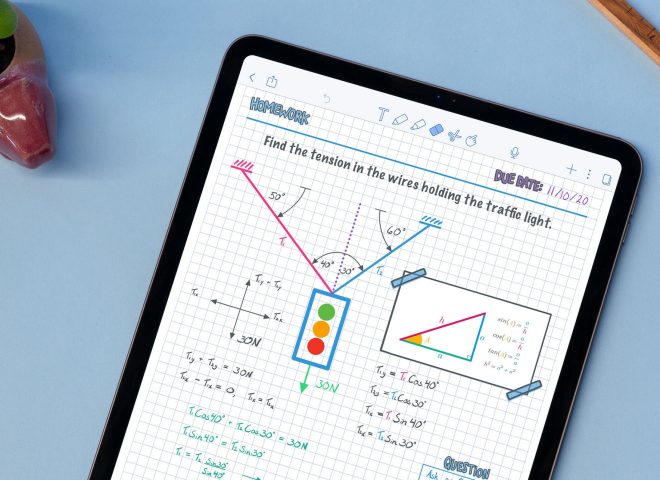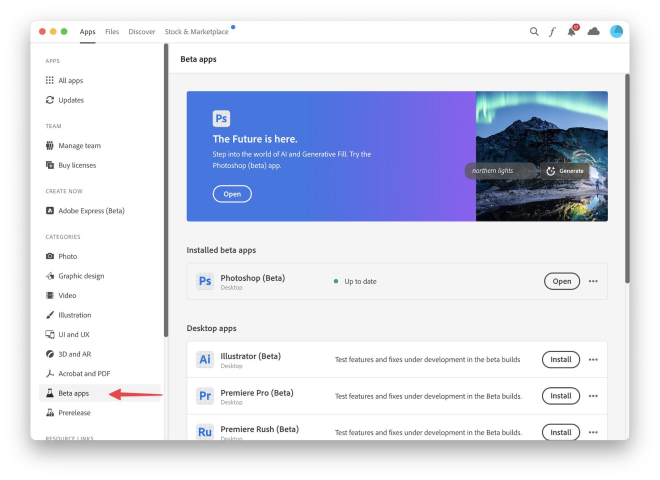
No team works without effective communication. The importance of strong communication increases with a remote team. In order to prioritize communication, we’ve implemented a number of guidelines to help ease the burden of trying to connect with teammates over the internet.
Establishing Meeting Structure
Using video for all meetings
Maybe you’ve participated in a conference call or video interview before. What if we told you that having the video turned on for every team call is mandatory for our company? Yes, this probably makes some people feel uneasy. But while It’s not always fun to see yourself in the video call, attempting to connect with others without being able to clearly see how they’re reacting is far less ideal. Seeing teammates on calls also helps us to not talk over each other because we’re able to see the visual indications whenever someone is about to speak.
Types of meetings and frequency
Many people appreciate having structure in an office space. Remote workers are no different. Creating repetition with the types of meetings and when they occur helps team members feel like they know what to expect and when. For example, during a typical week, employees at Astropad participate in a company-wide team call, a departmental team call, and a one-on-one with their manager. Consistent, recurring weekly meetings are essential to staying connected and feeling included.
Weekly team calls
Each Monday afternoon, Astropad hosts a one-hour team call. To promote team-bonding, we begin these Zoom calls with an ice-breaker question chosen by a team member. The topics range from “favorite meal to cook” to “the last show you binge-watched” and give us a way to connect and warm up before getting into work-talk. Every week a different person on the team poses a question to the group, and it naturally spurs conversation before we get into the company announcements and updates.
Departmental meetings
In addition to the weekly team-wide call, internal departments each hold their own weekly team meetings that last between an hour to an hour and a half. These calls are an essential way to feel connected to our departmental counterparts, and allow us to make sure everyone is on the same page, and discuss important tasks and questions.
To keep our meetings collaborative and organized, we use agendas to guide the discussions, and summary notes to keep track of our conclusions. After testing various tools, including a private WordPress blog and a trial run with Basecamp, we found that Notion was the perfect software to meet our needs. On our Marketing team, we use Notion each week to create meeting agendas prior to the video call to make sure no project updates slip through the cracks. After the call, our Marketing Manager recaps the discussion outcomes in the agenda, and then shares the notes in our Astropad Marketing Slack channel, so other departments can check it out.
One-on-ones
We also hold video one-on-one meetings between managers and employees on a weekly basis. These last between thirty minutes to an hour. As a manager, one-on-ones are fundamental for guiding a remote team since we’re not physically interacting with our direct reports every day. Having this allotted one-on-one time allows managers to get a sense of direct report morale, to learn more nuanced updates on projects that are easier discussed face-to-face (rather than online), and to help resolve any roadblocks they might be having. On top of that, it is yet another touchpoint that helps everyone bond and stay connected!
Quarterly company updates
Another staple at our company is holding quarterly team-wide updates. These serve as a way to communicate big picture strategies, financial updates, and where we’re headed. No matter the industry, the importance of transparency within the company is critical to managing employee morale. When everyone telecommutes, the need for transparency greatly increases, since the distance between coworkers can breed uncertainty.
At Astropad, we believe the survival of our business is heavily dependent on leadership being authentic and transparent with employees, so we make a point to constantly demonstrate these qualities. Some of the ways we do this are by sharing budget status updates and forecasts — even when the reports are more somber — and by creating a safe environment for people to voice questions, opinions, and feedback.
Communication Guidelines
Communication becomes much more nuanced when working remotely because we can’t rely on the the physical cues like facial expressions and tone of voice to aid in everyday conversations. Providing guidelines and structure on how to best communicate online and over video calls is vital to giving everyone a shot at speaking and being heard.
Organizing online conversations
Using Slack channels to streamline conversations
Our Slack channels are incredibly important. They help give purpose to our communication and sort conversations into the appropriate categories. When setting these channels up in the beginning, it’s a good idea to create some basic channels. For example, we have:
- An Astropad company channel for company-wide announcements, such as policy updates and out-of-office messages
- Departmental channels for Support, Engineering, Operations, and Marketing, where we announce big-picture campaigns and project updates
- A handful of social channels for “water cooler” talk, sharing photos of our kids and pets, and what we did over the weekend
These channels are great for general updates and conversation starters. Every company structure will have different demands, but starting with the basics will help determine whether anything else is missing.
To prevent flooding the departmental channels with frequent but minor queries, we also have specific channels for asking questions to teams. These channels, Ask Marketing, Ask Engineering, and Ask Support, are safe spaces where team members can ask any department-related questions, no matter how big or small, without worrying about disrupting the flow of the department’s main channel. This channel setup helps keep us organized because it keeps the department updates (in the basic channels) separate from questions (in the ask channels), so specific conversations are easier to locate and reference later on.
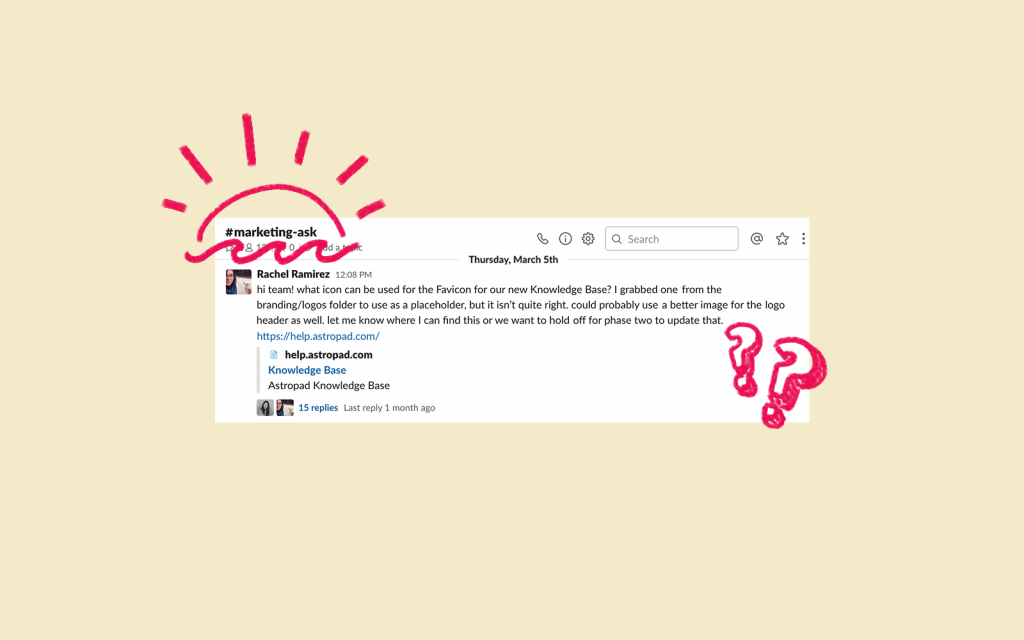
To help foster brainstorming, we created a channel just for that. The guidelines within this channel are more relaxed, so people can feel free to drop in product ideas and easily get team feedback.
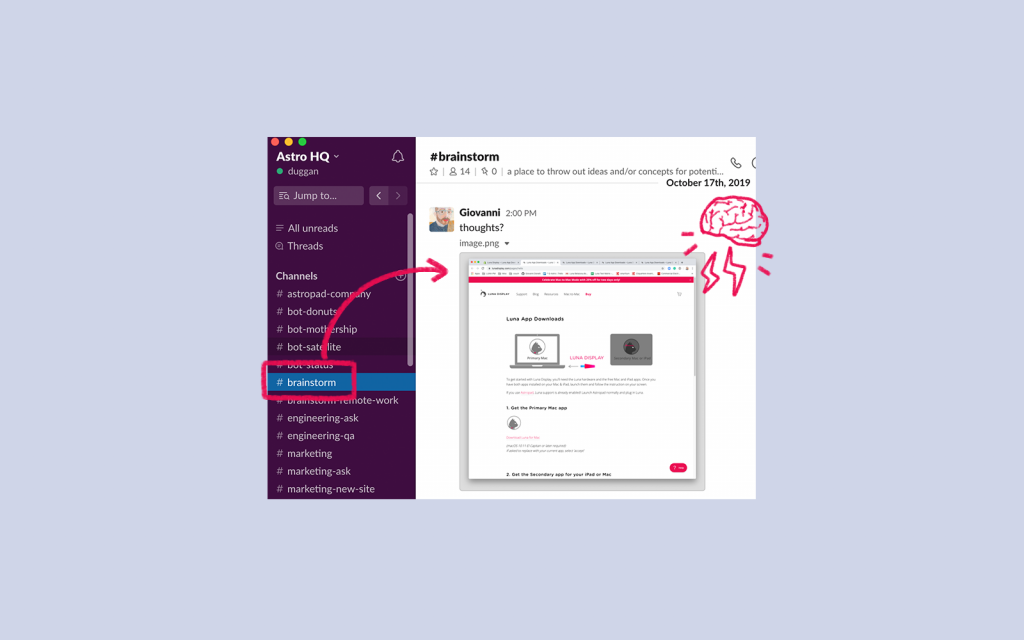
We also want to encourage staff conversations that are not work-related. These are a few just-for-fun channels we use:
- Book Club for recommending good reads, audiobooks, and podcasts
- Astrogram is our team Instagram to share pics with each other
- Random is exactly what it sounds like — a channel for random thoughts and commentary whether it be posting news articles, sharing memes and funny videos, or other online water cooler talk
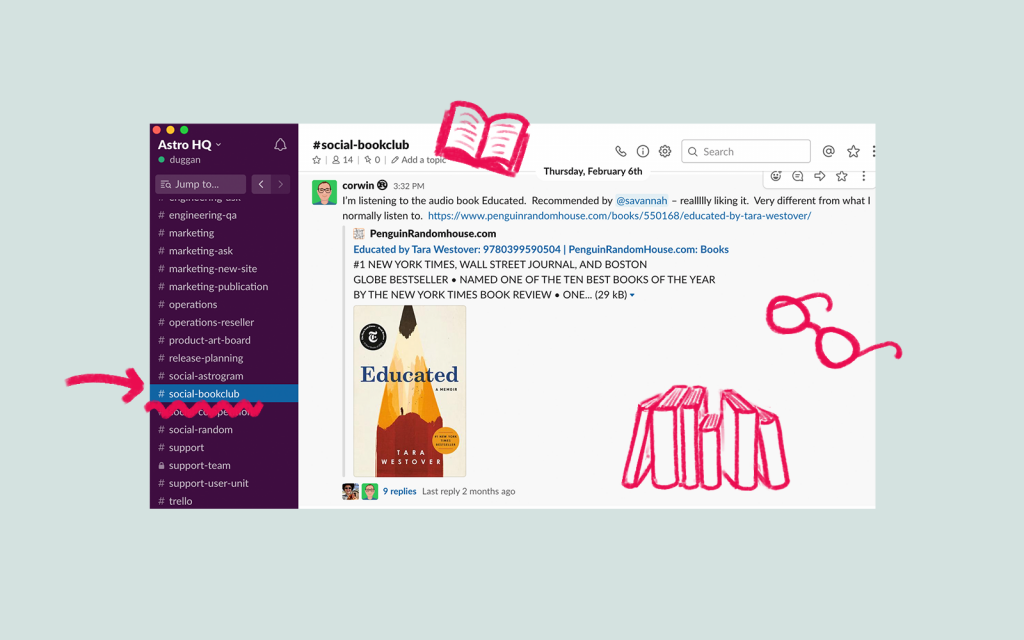
Using Slack threads to contain conversations
When you have only a few channels with just a handful of people, communication is fairly straightforward. As more people join the team, the number of conversations happening in different channels among team members at any given time can get chaotic.
One way that we’ve kept the conversations in check is by encouraging threads when replies don’t involve or aren’t relevant to everyone in the channel. Anytime someone posts, people who respond may do so by starting a thread to contain the conversation.
This helps make it easier to locate info from previous conversations, and it stops the main channel area from becoming a series of stream-of-consciousness posts. Plus, utilizing Slack threads saves everyone in the channel from getting lots of unnecessary notifications.
Using emojis for quick reactions
We all love using emojis. And, emoji use on Slack is highly recommended! If you choose to reply to a post using Slack’s emoji reaction feature, there’s no need to start a thread. A quick emoji response can be the perfect way to acknowledge a statement by another team member:

Using direct message for less-structured conversations
Let’s face it: sometimes it is hard to communicate online as a group. Sometimes, stream-of-consciousness chatting is the best way to shoot ideas back and forth and quickly resolve an issue or come to a conclusion on an idea. When it makes sense, take things to a DM to hash out the details directly to avoid creating a long, difficult-to-follow thread. Better yet, if both people are free, we’ll hop on a call to sort it out!
Sending signals in other settings
Using Slack statuses to indicate availability
Because we’re remote, we can’t always see when someone has stepped out of the office for a bit, but doing things like taking a lunch break or going for a walk don’t necessitate a company-wide announcement. So, at Astropad, we encourage status updates that let everyone know when you’re running an errand, at an appointment, in a meeting, or signing off to concentrate on a project (see the Deep work focus blocks section below). This simple action helps us be aware of what each other is up to and to understand the lack of or delay in response in that moment.
Deep work focus blocks
We encourage staff to take time away from notifications, chats, and the online chatter that happens every day. It can be hard to concentrate or meet a deadline when you are frequently getting pings on Slack – even if they’re not direct conversations involving you (like channel updates). We’ve established a norm where if you want or need time away from being active online, you can just notify others by updating your status with a quick note. Those notes include: deep work, focus block, writing, napping, and going for a walk — all are valid and welcomed.
Raise your hand in bigger meetings
As our Astropad team grew, we noticed that bigger meetings made it harder for people to interject or participate in an orderly and polite way. When you are physically in a conference room with a group of people, you have a better sense of when to speak and when to listen. In a video meeting, your awareness of others is, unfortunately, more skewed.
So now, when we’re on team video calls with over 5 participants, our approach is to have others raise their hands when they have a question or comment. This gesture allows everyone an equal opportunity to voice their opinions.
[thrive_leads id=’16549′]

